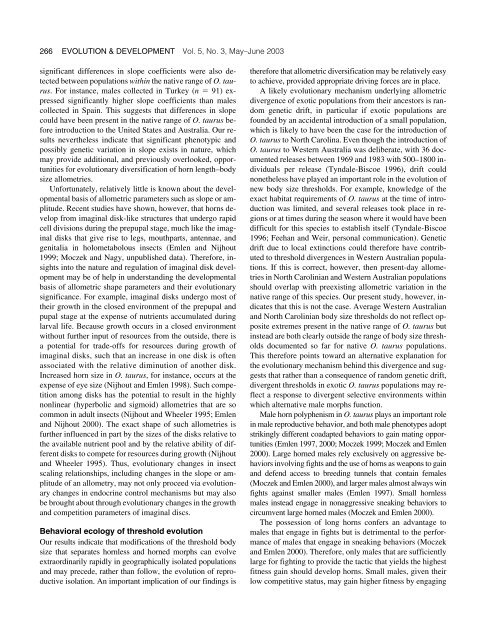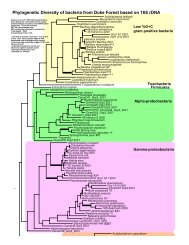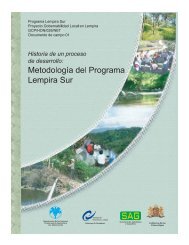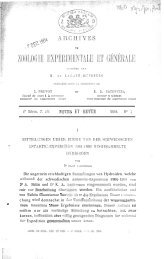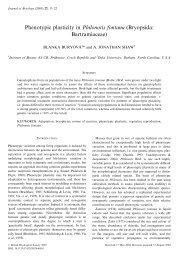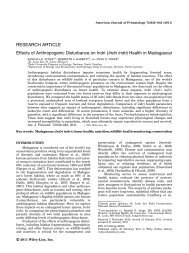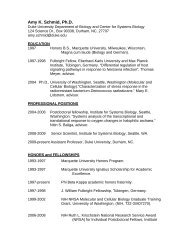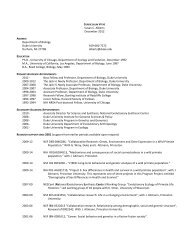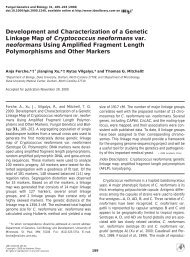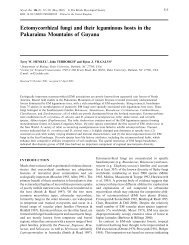Rapid evolution of a polyphenic threshold - Duke Biology - Duke ...
Rapid evolution of a polyphenic threshold - Duke Biology - Duke ...
Rapid evolution of a polyphenic threshold - Duke Biology - Duke ...
Create successful ePaper yourself
Turn your PDF publications into a flip-book with our unique Google optimized e-Paper software.
266 EVOLUTION & DEVELOPMENT Vol. 5, No. 3, May–June 2003<br />
significant differences in slope coefficients were also detected<br />
between populations within the native range <strong>of</strong> O. taurus.<br />
For instance, males collected in Turkey (n � 91) expressed<br />
significantly higher slope coefficients than males<br />
collected in Spain. This suggests that differences in slope<br />
could have been present in the native range <strong>of</strong> O. taurus before<br />
introduction to the United States and Australia. Our results<br />
nevertheless indicate that significant phenotypic and<br />
possibly genetic variation in slope exists in nature, which<br />
may provide additional, and previously overlooked, opportunities<br />
for <strong>evolution</strong>ary diversification <strong>of</strong> horn length–body<br />
size allometries.<br />
Unfortunately, relatively little is known about the developmental<br />
basis <strong>of</strong> allometric parameters such as slope or amplitude.<br />
Recent studies have shown, however, that horns develop<br />
from imaginal disk-like structures that undergo rapid<br />
cell divisions during the prepupal stage, much like the imaginal<br />
disks that give rise to legs, mouthparts, antennae, and<br />
genitalia in holometabolous insects (Emlen and Nijhout<br />
1999; Moczek and Nagy, unpublished data). Therefore, insights<br />
into the nature and regulation <strong>of</strong> imaginal disk development<br />
may be <strong>of</strong> help in understanding the developmental<br />
basis <strong>of</strong> allometric shape parameters and their <strong>evolution</strong>ary<br />
significance. For example, imaginal disks undergo most <strong>of</strong><br />
their growth in the closed environment <strong>of</strong> the prepupal and<br />
pupal stage at the expense <strong>of</strong> nutrients accumulated during<br />
larval life. Because growth occurs in a closed environment<br />
without further input <strong>of</strong> resources from the outside, there is<br />
a potential for trade-<strong>of</strong>fs for resources during growth <strong>of</strong><br />
imaginal disks, such that an increase in one disk is <strong>of</strong>ten<br />
associated with the relative diminution <strong>of</strong> another disk.<br />
Increased horn size in O. taurus, for instance, occurs at the<br />
expense <strong>of</strong> eye size (Nijhout and Emlen 1998). Such competition<br />
among disks has the potential to result in the highly<br />
nonlinear (hyperbolic and sigmoid) allometries that are so<br />
common in adult insects (Nijhout and Wheeler 1995; Emlen<br />
and Nijhout 2000). The exact shape <strong>of</strong> such allometries is<br />
further influenced in part by the sizes <strong>of</strong> the disks relative to<br />
the available nutrient pool and by the relative ability <strong>of</strong> different<br />
disks to compete for resources during growth (Nijhout<br />
and Wheeler 1995). Thus, <strong>evolution</strong>ary changes in insect<br />
scaling relationships, including changes in the slope or amplitude<br />
<strong>of</strong> an allometry, may not only proceed via <strong>evolution</strong>ary<br />
changes in endocrine control mechanisms but may also<br />
be brought about through <strong>evolution</strong>ary changes in the growth<br />
and competition parameters <strong>of</strong> imaginal discs.<br />
Behavioral ecology <strong>of</strong> <strong>threshold</strong> <strong>evolution</strong><br />
Our results indicate that modifications <strong>of</strong> the <strong>threshold</strong> body<br />
size that separates hornless and horned morphs can evolve<br />
extraordinarily rapidly in geographically isolated populations<br />
and may precede, rather than follow, the <strong>evolution</strong> <strong>of</strong> reproductive<br />
isolation. An important implication <strong>of</strong> our findings is<br />
therefore that allometric diversification may be relatively easy<br />
to achieve, provided appropriate driving forces are in place.<br />
A likely <strong>evolution</strong>ary mechanism underlying allometric<br />
divergence <strong>of</strong> exotic populations from their ancestors is random<br />
genetic drift, in particular if exotic populations are<br />
founded by an accidental introduction <strong>of</strong> a small population,<br />
which is likely to have been the case for the introduction <strong>of</strong><br />
O. taurus to North Carolina. Even though the introduction <strong>of</strong><br />
O. taurus to Western Australia was deliberate, with 36 documented<br />
releases between 1969 and 1983 with 500–1800 individuals<br />
per release (Tyndale-Biscoe 1996), drift could<br />
nonetheless have played an important role in the <strong>evolution</strong> <strong>of</strong><br />
new body size <strong>threshold</strong>s. For example, knowledge <strong>of</strong> the<br />
exact habitat requirements <strong>of</strong> O. taurus at the time <strong>of</strong> introduction<br />
was limited, and several releases took place in regions<br />
or at times during the season where it would have been<br />
difficult for this species to establish itself (Tyndale-Biscoe<br />
1996; Feehan and Weir, personal communication). Genetic<br />
drift due to local extinctions could therefore have contributed<br />
to <strong>threshold</strong> divergences in Western Australian populations.<br />
If this is correct, however, then present-day allometries<br />
in North Carolinian and Western Australian populations<br />
should overlap with preexisting allometric variation in the<br />
native range <strong>of</strong> this species. Our present study, however, indicates<br />
that this is not the case. Average Western Australian<br />
and North Carolinian body size <strong>threshold</strong>s do not reflect opposite<br />
extremes present in the native range <strong>of</strong> O. taurus but<br />
instead are both clearly outside the range <strong>of</strong> body size <strong>threshold</strong>s<br />
documented so far for native O. taurus populations.<br />
This therefore points toward an alternative explanation for<br />
the <strong>evolution</strong>ary mechanism behind this divergence and suggests<br />
that rather than a consequence <strong>of</strong> random genetic drift,<br />
divergent <strong>threshold</strong>s in exotic O. taurus populations may reflect<br />
a response to divergent selective environments within<br />
which alternative male morphs function.<br />
Male horn polyphenism in O. taurus plays an important role<br />
in male reproductive behavior, and both male phenotypes adopt<br />
strikingly different coadapted behaviors to gain mating opportunities<br />
(Emlen 1997, 2000; Moczek 1999; Moczek and Emlen<br />
2000). Large horned males rely exclusively on aggressive behaviors<br />
involving fights and the use <strong>of</strong> horns as weapons to gain<br />
and defend access to breeding tunnels that contain females<br />
(Moczek and Emlen 2000), and larger males almost always win<br />
fights against smaller males (Emlen 1997). Small hornless<br />
males instead engage in nonaggressive sneaking behaviors to<br />
circumvent large horned males (Moczek and Emlen 2000).<br />
The possession <strong>of</strong> long horns confers an advantage to<br />
males that engage in fights but is detrimental to the performance<br />
<strong>of</strong> males that engage in sneaking behaviors (Moczek<br />
and Emlen 2000). Therefore, only males that are sufficiently<br />
large for fighting to provide the tactic that yields the highest<br />
fitness gain should develop horns. Small males, given their<br />
low competitive status, may gain higher fitness by engaging


